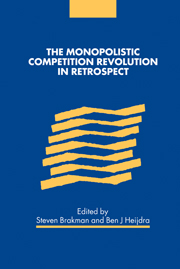Book contents
- Frontmatter
- Contents
- List of contributors
- Preface
- 1 Introduction
- Part I Underground classics
- Part II Current Perspectives
- Part III International trade
- Part IV Economic geography
- Part V Economic growth
- Part VI Macroeconomics
- 17 Monopolistic competition and macroeconomics: theory and quantitative implications
- 18 Does competition make firms enterprising or defensive?
- 19 Rationalisation and specialisation in start-up investment
- 20 Industrial policy in a small open economy
- Index
19 - Rationalisation and specialisation in start-up investment
Published online by Cambridge University Press: 22 September 2009
- Frontmatter
- Contents
- List of contributors
- Preface
- 1 Introduction
- Part I Underground classics
- Part II Current Perspectives
- Part III International trade
- Part IV Economic geography
- Part V Economic growth
- Part VI Macroeconomics
- 17 Monopolistic competition and macroeconomics: theory and quantitative implications
- 18 Does competition make firms enterprising or defensive?
- 19 Rationalisation and specialisation in start-up investment
- 20 Industrial policy in a small open economy
- Index
Summary
Introduction
The accumulation of machinery and equipment is one of the prime determinants of productivity growth. As economic historians often argue, the richest countries were the first in inventing and adopting capital-intensive production techniques to exploit the productivity gains from rationalisation and mass production. At the same time, equipment investment is seen as the main vehicle to introduce innovations and to advance the specialisation and division of labour in industrial production. Unsurprisingly, investment promotion has always been high on the priority list of policy makers. This interest in encouraging fixed-capital formation implicitly rests on the presumption that private returns fall short of the full social returns to investment due to some unappropriated spillovers to the business community. De Long and Summers (1991), for example, argue along these lines. They found a strong and robust statistical relationship between national rates of machinery and equipment investment and productivity growth. They claim that the social returns to equipment investment by far exceed the private returns. Some form of investment promotion would help. To keep up in high-tech fields, governments are particularly interested in start-up investment that establishes new firms and production lines. They are seen as a source of innovative products and specialised services. Therefore, governments often prefer start-up subsidies to accelerate the rate of business formation.
We outline an intertemporal equilibrium model with monopolistic competition among diversified producers and start-up investment in equipment and machinery.
- Type
- Chapter
- Information
- The Monopolistic Competition Revolution in Retrospect , pp. 417 - 441Publisher: Cambridge University PressPrint publication year: 2001

